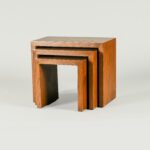Welcome to the captivating world of furniture making, where craftsmanship and creativity converge to create stunning works of art. In this article, we will delve into the realm of facts about furniture making, uncovering intriguing insights that will leave you amazed and enlightened. From the intricacies of joinery techniques to the secrets behind the perfect finish, join me as we explore the fascinating journey of mastering the craft. So, fasten your seatbelts and get ready to embark on a captivating adventure into the world of furniture making.

Facts About Furniture Making
If you’ve ever marveled at the beauty and craftsmanship of a well-made piece of furniture, you might be interested to know some fascinating facts about furniture making. From its humble origins to the intricate techniques employed by skilled craftsmen, furniture making has a rich history that continues to shape our living spaces today.
- Origins and Evolution: Let’s start with the word “furniture” itself. Did you know that it comes from the French word “fournir,” meaning “to furnish”? This simple term encompasses the art of transforming raw materials into functional and aesthetically pleasing objects. From early animal hides and tree stumps to the modern use of wood, metal, plastics, and other materials, furniture making has come a long way.
“From the ancient use of animal hides to the modern fusion of different materials, furniture making has evolved dramatically throughout history.”
- The Oldest Piece: The oldest piece of furniture ever discovered is a wooden mausoleum made 2,700 years ago. This remarkable find shows that the need for furniture and the skills to create it have been ingrained in human civilization since ancient times.
“Ancient craftsmen demonstrated their ingenuity and skill by creating furniture that still stands as a testament to their craftsmanship thousands of years later.”
- From Tree Stumps to Plywood: Early furniture was often made from natural materials like tree stumps and hollowed-out logs. As civilizations developed, so did furniture making techniques. Today, modern manufacturing relies on the economical use of materials like natural wood and plywood, ensuring both durability and sustainability.
“Just as our ancestors used tree stumps and logs, modern furniture makers have found innovative ways to incorporate natural materials into their designs while embracing new techniques and materials.”
- Functional and Aesthetic Designs: Furniture serves both functional and aesthetic purposes. Throughout history, furniture styles have been influenced by different cultures and periods, such as the distinct styles of Greek and Roman civilizations. From couches and chairs to stools, tables, chests, and boxes, each piece has its own story to tell.
“Every piece of furniture carries the imprint of its time and culture, reflecting the unique aesthetics and tastes that shaped its design.”
- Building Blocks of Furniture: The art of furniture making lies in the ability to create sturdy and reliable joinery. Different woodworking joints have been used across cultures and time periods, reflecting local preferences and craftsmanship traditions. Understanding how to construct these joints is key to ensuring the longevity of furniture pieces.
“Craftsmen have mastered the art of joinery, using techniques that have been passed down through generations to create furniture that withstands the tests of time.”
- Form and Function Balance: Balancing form and function is a delicate task in furniture making. Aesthetics and comfort go hand in hand, as each piece should enhance a space while delivering utmost comfort and durability. From the wings on winged-back furniture to the use of upholstery, every design element serves a purpose.
“Skilled craftsmen meticulously consider every detail, from the shape and structure of a piece to the smallest decorative elements, ensuring that each furniture item serves both practical and aesthetic purposes.”
- Preserving Tradition, Embracing Innovation: Furniture making is a blend of tradition and innovation. While honoring traditional techniques, craftsmen embrace modern advancements and materials, creating pieces that harmoniously bridge the past and the present. This balance ensures that furniture making remains an ever-evolving craft.
“Today’s furniture makers continue to pay homage to the rich history of their craft while incorporating modern innovations, resulting in exquisite pieces that blend tradition and contemporary design.”
As you can see, furniture making is an art that encompasses history, materials, craftsmanship, and design. From its ancient roots to the modern-day creations, this craft continues to captivate and enhance our living spaces. So, the next time you admire a well-crafted piece of furniture, take a moment to appreciate the fascinating facts behind its creation.
“In the hands of skilled craftsmen, the raw materials of furniture making are transformed into functional works of art, enriching our lives and surroundings.”
Furniture is an essential part of any living space. Whether you’re furnishing your home or office, it’s important to know some interesting and surprising facts about furniture. Did you know that certain furniture pieces can actually improve your health? From ergonomic chairs that support your back to standing desks that promote better posture, furniture has come a long way in providing both style and functionality.
If you’re a history buff, you’ll be fascinated to learn that furniture has been around since ancient times. From ancient Egypt to medieval Europe, furniture has always played a significant role in human civilization. With so much rich history, it’s no wonder that furniture has become an art form in itself.
If you’re curious to know more about the fascinating world of furniture, check out our comprehensive guide on facts about furniture. From the origins of different furniture styles to the latest trends in interior design, this guide will leave you inspired and informed. So why wait? Click here to explore the wonderful world of furniture: facts about furniture.
Facts about Furniture Making
Are you curious about the fascinating world of furniture making? From the techniques used to create exquisite pieces to the historical significance behind certain designs, there is so much to discover. If you’re interested in learning some interesting facts about furniture making, you’ve come to the right place!
One area that might pique your curiosity is the rich history of furniture making. Did you know that certain designs can trace their origins back centuries? Click here to explore some historical facts about furniture making and gain a deeper appreciation for the craftsmanship of the past. historical facts about furniture making
If you’re more interested in the techniques and skills used by furniture makers, look no further. Furniture making is an art form that requires precision and expertise. Discover unique furniture making techniques and uncover some surprising facts along the way. Click this link to delve into the world of furniture making techniques and facts. furniture making techniques and facts
For those who love random tidbits of information, we have a treat for you. Explore a collection of intriguing and lesser-known facts about furniture making that will leave you amazed. Whether you’re a furniture enthusiast or simply enjoy expanding your knowledge, these interesting facts will captivate your imagination. Discover them all by clicking on this link: interesting facts about furniture making
As you continue on your journey of exploration, remember that furniture making is more than just assembling wood and materials. It is an art that intertwines history, skill, and creativity. So why not embark on a fascinating adventure through the world of furniture making? Click on the links above and delve into the captivating realm of furniture craftsmanship.
of different materials – Woodworking is a popular form of furniture making that requires skill and precision – In this article, we will explore six woodworking tips and tricks for beginners that will help them become more efficient and productive in their craft.]
[youtube v=”3cME3vK1aaQ”]
Woodworking is a craft that requires skill, patience, and attention to detail. Whether you’re an experienced woodworker or just starting out, having tips and tricks can greatly improve your efficiency and help you complete projects faster. In this article, we will explore six woodworking tips and tricks for beginners that will enhance your woodworking skills and make your projects more enjoyable.
Tip #1: Create a Center Marking Gauge
A center marking gauge is a simple tool that can help you mark accurate center lines on your woodworking projects. To create one, all you need is a piece of scrap wood. Start by establishing a line down the center of the wood. Then, mark off three points in the center and two on the sides for the pins.
To simplify this process, you can use round head screws instead of pins. If you don’t have a drill press, you can still create holes in the wood by using a scrap piece as a guide. Draw a straight line on the scrap wood and rest the bit against it to keep it straight. Once you have the holes drilled, use wood glue to secure the screws in place. Finally, make sure the marking gauge is squared and ready to use. By using a screw instead of a pencil, you have the advantage of adjusting the depth of your scribe, allowing for a deeper cut.
Tip #2: Utilize Spring Clamps
Spring clamps are affordable and versatile tools that every woodworker should have. They are handy for various tasks, including attaching pieces of trim. To use them for this purpose, apply glue to the trim and then use the rubber part of the clamps to hold it in place. The rubber provides a firm grip and prevents the piece from moving during the drying process. This is especially useful when a bar clamp is too cumbersome or tends to shift the piece.
To create a temporary fix for the spring clamps, you can use rubber bands. Grab two loops of the rubber bands and bring them over the top of each clamp, leaving them to rest there. Repeat this step on the opposite side. This quick method provides enough tension to secure the piece in place. While these clamps might not last forever, they are a great solution in a pinch.
Tip #3: Use Right Angle Clamp Jigs
Right angle clamp jigs are incredibly useful when you need to join pieces together at a 90-degree angle. To create a simple and effective right angle clamp jig, start with a straight piece of plywood or MDF. Set your miter gauge on your table saw to make a 45-degree cut. Make the first pass, flip the board around, and make another pass. This will leave you with two 45-degree pieces.
By using the first cut as a stop block, set the miter saw to cut down interference on the corner and prevent the edges from being chipped off. Remove any excess material that might hinder the right angle corner. To assemble the jig, cut holes in the plywood according to a template to ensure consistency. A 1 3/8-inch forcing bit is a suitable choice for drilling the holes.
For beginners, it is recommended to create multiple right angle clamp jigs to have on hand. These jigs are extremely handy and can be used to align and clamp pieces together, whether at a corner or an intersection. You can use the holes in the jig to accommodate various clamps, such as spring clamps or bar clamps, depending on your needs.
Tip #4: Use a Sacrificial Fence for Repeatable Cuts
When you need to make repeatable cuts of different lengths, a sacrificial fence can help you achieve accuracy and consistency. To create a sacrificial fence, all you need is a piece of scrap wood or a sacrificial fence attachment. Attach a 2×2 piece of wood to the miter saw table using the existing holes and long screws. This will act as a guide for your cuts, allowing you to quickly and easily transfer measurements and make precise, repeatable cuts.
While having a miter station would eliminate the need for a sacrificial fence, this method is a quick and simple solution for those without a dedicated workstation. It allows you to make quick and accurate cuts without the need for additional measuring tools.
Tip #5: Prevent Shifting with Salt
When gluing multiple pieces of lumber together, one common problem is shifting and movement once clamps are applied. To prevent this, an old woodworking trick is to sprinkle a little salt on the glued parts. The salt acts as a grip and prevents shifting.
This method works well for materials like 2x4s or plywood, where slipping and shifting can be an issue. When gluing two pieces together, a little salt sprinkled between them will hold them securely in place. This trick can also be used with wood glue and provides a simple solution to prevent shifting and misalignment when clamping pieces together.
Tip #6: Substitute Dowel Jigs with Nails
Joining pieces of wood together with dowels can be challenging, especially for beginners who may not have a dowel jig or find it difficult to use. However, there is a simple workaround that involves using small nails as a substitute dowel jig.
To achieve this, place a small nail between the two areas you want to join. You can use one, two, or three nails, securing them in place with tape. This creates a temporary guide for drilling the dowel holes. After marking the holes with the nails, remove them and drill the holes accordingly. Apply wood glue to the holes, clamp the pieces together, and you will have a solid joint.
These six woodworking tips and tricks for beginners can enhance your woodworking skills and make your projects more efficient and enjoyable. By creating a center marking gauge, utilizing spring clamps, using right angle clamp jigs, employing a sacrificial fence, preventing shifting with salt, and substituting dowel jigs with nails, you can improve your woodworking techniques and achieve better results in your projects. Whether you are just starting out or have some experience in woodworking, these tips will help you become more efficient and productive in your craft.
FAQ
Question 1
What is the origin of the word “furniture”?
Answer 1
The word “furniture” comes from the French word “fournir,” meaning “to furnish.”
Question 2
What is the oldest known piece of furniture?
Answer 2
The oldest piece of furniture ever found was a wooden mausoleum made 2,700 years ago.
Question 3
What materials were early furniture made from?
Answer 3
Early furniture was made from animal hides, tree stumps, and hollowed-out logs.
Question 4
What materials are commonly used in furniture making?
Answer 4
Furniture is typically made from wood, metal, plastics, marble, glass, fabrics, or related materials.
Question 5
When did furniture design and manufacture become a major industry?
Answer 5
The design and manufacture of furniture became a major mass-production industry in the 20th century.
- Star Ring Trends: Etsy vs Amazon - March 28, 2025
- Boost Pollinator Habitats: Baby Blue Eyes Sustainable Farming Guide - March 28, 2025
- Protect Big Black Bears: Effective Conservation Strategies - March 28, 2025
















